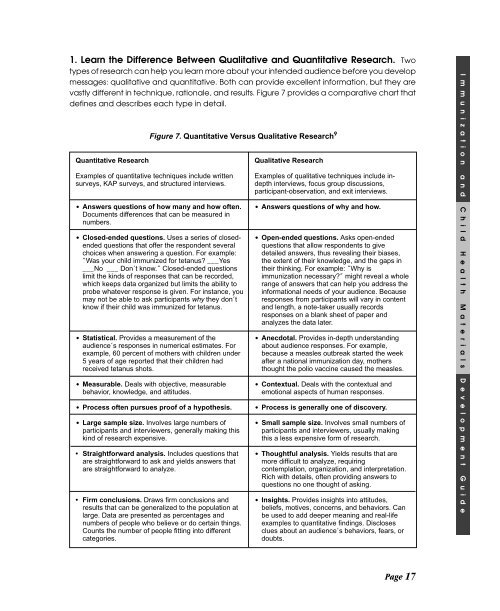Immunization and child health materials development guide pdf
Immunization and child health materials development guide pdf
Immunization and child health materials development guide pdf
Create successful ePaper yourself
Turn your PDF publications into a flip-book with our unique Google optimized e-Paper software.
1. Learn the Difference Between Qualitative <strong>and</strong> Quantitative Research. Two<br />
types of research can help you learn more about your intended audience before you develop<br />
messages: qualitative <strong>and</strong> quantitative. Both can provide excellent information, but they are<br />
vastly different in technique, rationale, <strong>and</strong> results. Figure 7 provides a comparative chart that<br />
defines <strong>and</strong> describes each type in detail.<br />
Figure 7. Quantitative Versus Qualitative Research 9<br />
Quantitative Research<br />
Examples of quantitative techniques include written<br />
surveys, KAP surveys, <strong>and</strong> structured interviews.<br />
• Answers questions of how many <strong>and</strong> how often.<br />
Documents differences that can be measured in<br />
numbers.<br />
• Closed-ended questions. Uses a series of closedended<br />
questions that offer the respondent several<br />
choices when answering a question. For example:<br />
“Was your <strong>child</strong> immunized for tetanus? ___Yes<br />
___No ___ Don’t know.” Closed-ended questions<br />
limit the kinds of responses that can be recorded,<br />
which keeps data organized but limits the ability to<br />
probe whatever response is given. For instance, you<br />
may not be able to ask participants why they don’t<br />
know if their <strong>child</strong> was immunized for tetanus.<br />
• Statistical. Provides a measurement of the<br />
audience’s responses in numerical estimates. For<br />
example, 60 percent of mothers with <strong>child</strong>ren under<br />
5 years of age reported that their <strong>child</strong>ren had<br />
received tetanus shots.<br />
• Measurable. Deals with objective, measurable<br />
behavior, knowledge, <strong>and</strong> attitudes.<br />
• Process often pursues proof of a hypothesis.<br />
• Large sample size. Involves large numbers of<br />
participants <strong>and</strong> interviewers, generally making this<br />
kind of research expensive.<br />
• Straightforward analysis. Includes questions that<br />
are straightforward to ask <strong>and</strong> yields answers that<br />
are straightforward to analyze.<br />
• Firm conclusions. Draws firm conclusions <strong>and</strong><br />
results that can be generalized to the population at<br />
large. Data are presented as percentages <strong>and</strong><br />
numbers of people who believe or do certain things.<br />
Counts the number of people fitting into different<br />
categories.<br />
Qualitative Research<br />
Examples of qualitative techniques include indepth<br />
interviews, focus group discussions,<br />
participant-observation, <strong>and</strong> exit interviews.<br />
• Answers questions of why <strong>and</strong> how.<br />
• Open-ended questions. Asks open-ended<br />
questions that allow respondents to give<br />
detailed answers, thus revealing their biases,<br />
the extent of their knowledge, <strong>and</strong> the gaps in<br />
their thinking. For example: “Why is<br />
immunization necessary?” might reveal a whole<br />
range of answers that can help you address the<br />
informational needs of your audience. Because<br />
responses from participants will vary in content<br />
<strong>and</strong> length, a note-taker usually records<br />
responses on a blank sheet of paper <strong>and</strong><br />
analyzes the data later.<br />
• Anecdotal. Provides in-depth underst<strong>and</strong>ing<br />
about audience responses. For example,<br />
because a measles outbreak started the week<br />
after a national immunization day, mothers<br />
thought the polio vaccine caused the measles.<br />
• Contextual. Deals with the contextual <strong>and</strong><br />
emotional aspects of human responses.<br />
• Process is generally one of discovery.<br />
• Small sample size. Involves small numbers of<br />
participants <strong>and</strong> interviewers, usually making<br />
this a less expensive form of research.<br />
• Thoughtful analysis. Yields results that are<br />
more difficult to analyze, requiring<br />
contemplation, organization, <strong>and</strong> interpretation.<br />
Rich with details, often providing answers to<br />
questions no one thought of asking.<br />
• Insights. Provides insights into attitudes,<br />
beliefs, motives, concerns, <strong>and</strong> behaviors. Can<br />
be used to add deeper meaning <strong>and</strong> real-life<br />
examples to quantitative findings. Discloses<br />
clues about an audience’s behaviors, fears, or<br />
doubts.<br />
Page 17

















